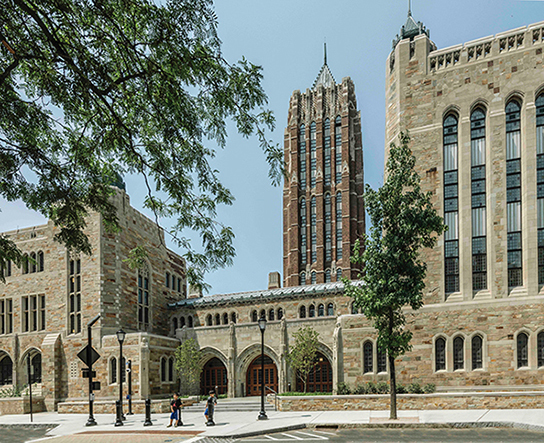
Peter Vanderwarker
The main entrance to 320 York Street, which was once an open loggia, was enclosed to provide all-weather lobby space for the building. The tower looming behind, renamed Swensen Tower in 2015 for the late chief investment officer David Swensen ’80PhD, once was a residence for graduate students; now it’s set aside for grad student study space.
View full image

Peter Vanderwarker
The main entrance to 320 York Street, which was once an open loggia, was enclosed to provide all-weather lobby space for the building. The tower looming behind, renamed Swensen Tower in 2015 for the late chief investment officer David Swensen ’80PhD, once was a residence for graduate students; now it’s set aside for grad student study space.
View full image
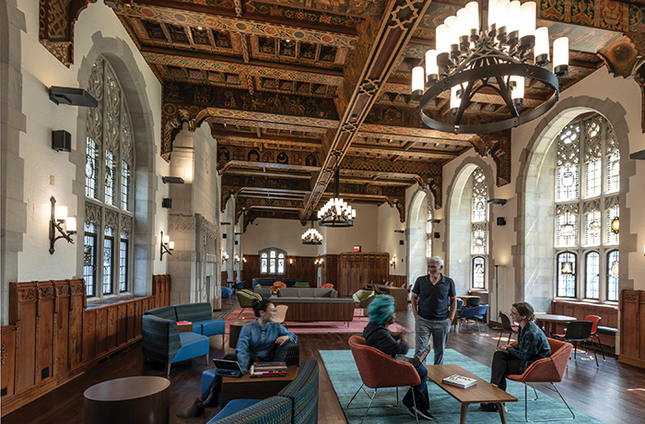
Peter Vanderwarker
The former HGS common room serves a similar purpose in the Humanities Quadrangle: as a lounge for students. As in much of the building, the furniture is more modern and colorful than before, and lightweight to allow users to move it around easily.
View full image

Peter Vanderwarker
The former HGS common room serves a similar purpose in the Humanities Quadrangle: as a lounge for students. As in much of the building, the furniture is more modern and colorful than before, and lightweight to allow users to move it around easily.
View full image
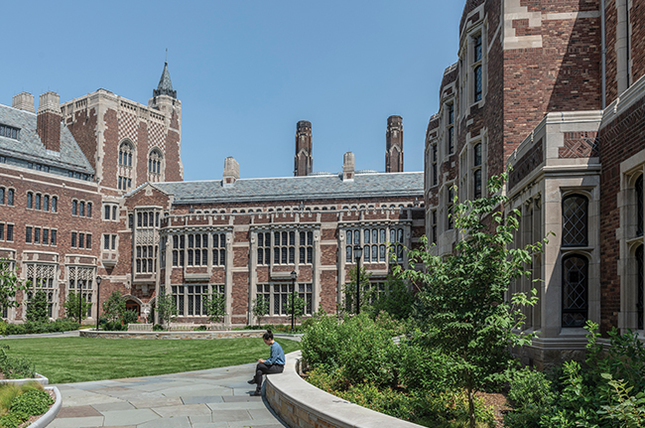
Peter Vanderwarker
The lawn of the courtyard was replaced after an elaborate construction project that added a large lecture hall and a film screening room beneath it.
View full image

Peter Vanderwarker
The lawn of the courtyard was replaced after an elaborate construction project that added a large lecture hall and a film screening room beneath it.
View full image
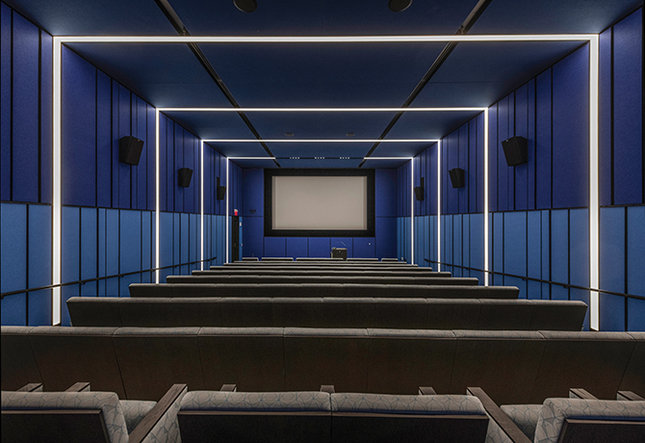
Peter Vanderwarker
Two floors below the courtyard, a new film screening room that seats 90 people was added. Named the Alice Cinema in honor of French film pioneer Alice Guy-Blaché (1873–1968), the screening room will be used by the film and media studies program, which is housed in HQ, and for other screenings. A new 190-seat lecture hall nearby is also equipped for film screenings.
View full image

Peter Vanderwarker
Two floors below the courtyard, a new film screening room that seats 90 people was added. Named the Alice Cinema in honor of French film pioneer Alice Guy-Blaché (1873–1968), the screening room will be used by the film and media studies program, which is housed in HQ, and for other screenings. A new 190-seat lecture hall nearby is also equipped for film screenings.
View full image
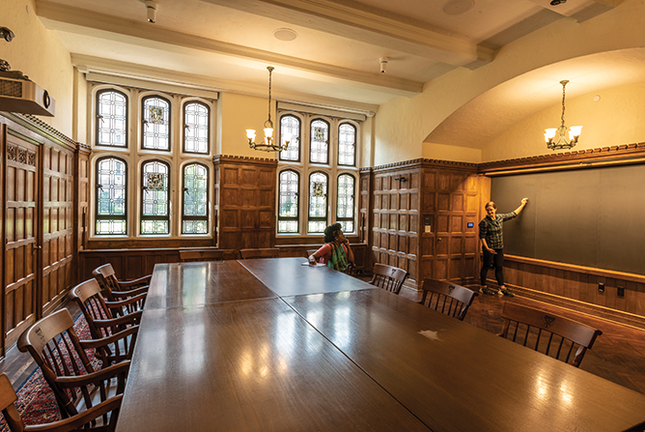
Peter Vanderwarker
One of the HQ’s 28 classrooms shows the work that went into restoring the building’s woodwork, intricate windows, and other details.
View full image

Peter Vanderwarker
One of the HQ’s 28 classrooms shows the work that went into restoring the building’s woodwork, intricate windows, and other details.
View full image
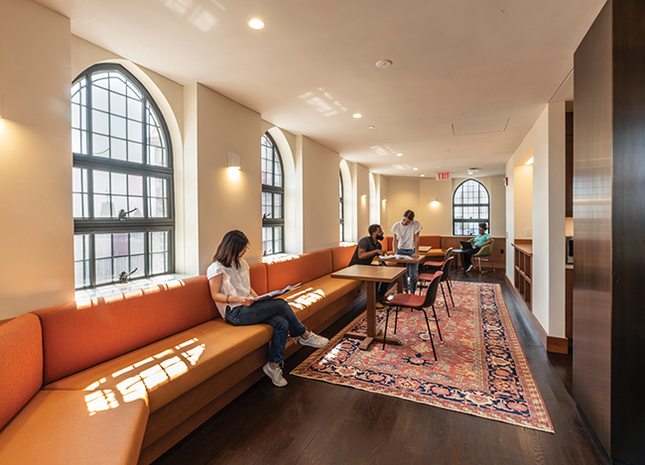
Peter Vanderwarker
Most of the space in Swensen Tower is given over to open-plan study space for graduate students, but the top floor, with commanding views of the campus, is equipped for receptions and special events.
View full image

Peter Vanderwarker
Most of the space in Swensen Tower is given over to open-plan study space for graduate students, but the top floor, with commanding views of the campus, is equipped for receptions and special events.
View full image
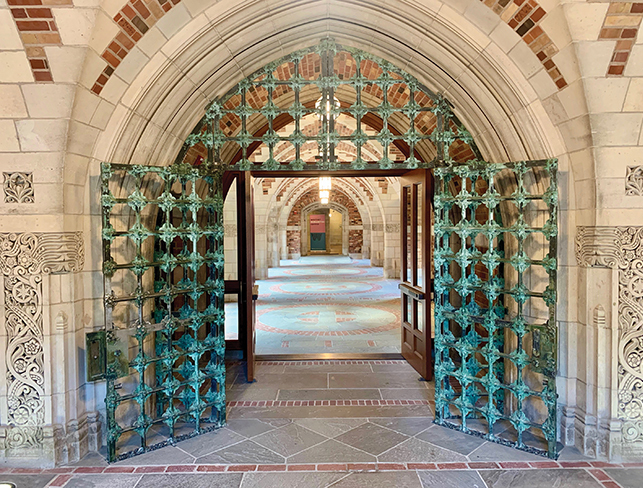
Mark Alden Branch ’86
The building’s entrance loggia is now enclosed lobby space. The building’s exuberant stone carving has been preserved, and the great wrought iron gates by Samuel Yellin were restored and are now permanently open.
View full image

Mark Alden Branch ’86
The building’s entrance loggia is now enclosed lobby space. The building’s exuberant stone carving has been preserved, and the great wrought iron gates by Samuel Yellin were restored and are now permanently open.
View full image
Ask where science lives at Yale, and most people have a pretty good idea; the name “Science Hill” is a big tipoff. But where is the home of the humanities on campus? That’s a tougher question. There are 25 academic departments, programs, and centers under the umbrella of the humanities division, and they have historically been scattered all over the university. But since last year, 15 of them have been gathered together under one roof for the first time, in a building the university has renamed the Humanities Quadrangle. Of course, everyone calls it HQ.
Most alumni will remember that building as the Hall of Graduate Studies, the imposing structure on York Street that once functioned both as an administrative home and as something like a residential college for the Graduate School of Arts and Sciences. Built in 1932, HGS contained residential space for 150 to 200 graduate students, a dining hall, a common room, a student center, classrooms, some faculty offices, and administrative offices for the Grad School. When HGS got its turn for a long-overdue renovation, the university decided to disperse the Graduate School functions (see sidebar, page 49) and reimagine the quadrangle as a place where students and faculty in the humanities could work together across disciplinary lines.
That idea builds on Yale’s longstanding strengths in the humanities, and also on the creative interactions between the various humanities departments. “Yale has more jointly appointed faculty in the humanities than any of its peers,” says Kathryn Lofton, dean of humanities for the Faculty of Arts and Sciences and the Lex Hixon Professor of Religious Studies and American Studies. “This building is a great expression of what was already true at Yale.”
Of course, Yale has long had a much smaller center for the humanities: the Whitney Humanities Center has promoted scholarly exchange and hosted lectures, conferences, and fellows ever since it was established in 1981 with a gift from John Hay Whitney ’26. The WHC now has a prominent new home in HQ, with an entrance just inside the main entrance on York Street. (The center has first dibs on the large meeting rooms carved out of the former HGS dining hall near its offices.) The location is a big improvement on the WHC’s former home, notes Paul North, a professor of German who served as its interim director last year. After years on the very edge of campus, at 53 Wall Street, he says, the WHC “feels integrated into the life of the humanities in a way we weren’t before.”
Also housed in HQ is another program central to the life of the humanities: Directed Studies, the select program for first-year students in Yale College that surveys Western history, philosophy, and literature in three integrated year-long courses. All of the Directed Studies lectures and most of the discussion seminars are now held in HQ, and the program has its offices there.
The old HGS was home to many humanities departments and programs that remain in the building today: history, American studies, East Asian languages and literatures, Near Eastern languages and civilizations, and Slavic languages and literatures. They’re joined in the new HQ by comparative literature, film and media studies, humanities, French, Germanic languages and literatures, Italian studies, Judaic studies, Medieval and Renaissance studies, religious studies, and Spanish and Portuguese.
Ann Beha, whose firm Ann Beha Architects designed the project, says that Yale wanted to make the most of the new arrangement. “These departments had not cohabitated, so having shared spaces where they would actually meet each other is very important.” For example, the architects made sure to provide room for couches and chairs and tables in corridors and in administrative offices, “making it possible for people to feel that they can take a quick breath and sit down with colleagues,” Beha says.
Not all of Yale’s humanities departments could fit in the building. Some were content in their existing homes: English in Linsly-Chittenden Hall, classics in Phelps Hall, and philosophy in Connecticut Hall, for example. But Lofton says the interdisciplinary programs in HQ, along with “28 really excellent classrooms” available for teaching, draw in faculty who usually work elsewhere.
Although the building is no longer identified as the Graduate School, there is one piece of the HQ dedicated to graduate students’ needs. The building’s 14-story tower was once grad student housing; today, it is much-needed study space for graduate students. (The top floor, with a remarkable view of the campus, is available for events.) Grad students flock to the tower to study—although undergraduates, always on the prowl for study space, sometimes claim more space than they should.
Renovating and restoring the quadrangle took 30 months, lots of money, and a fair amount of structural gymnastics. The building’s courtyard was excavated in order to add both a new lecture hall and a cinema two floors underground, and new stairs and corridors were added to make the formerly labyrinthine building more navigable.
With the campus still living under the strictures of COVID precautions, it’s hard to evaluate the success of a project that was designed to promote community. But Lofton says so far, so good. “It’s stunning to me,” she says. “From the moment we opened on September 1, it’s been packed.”
 loading
loading
2 comments
-

Ann Beha FAIA, 12:21pm March 12 2022 |  Flag as inappropriate
Flag as inappropriate
-

Lisa Villeneuve, PhD., 2:44pm April 16 2022 |  Flag as inappropriate
Flag as inappropriate
The comment period has expired.Thanks to the amazing representatives of the Yale Facilties Dept--a shout out to Bryan D'Orlando, to Jim Elmasry AIA, and to Keith Fordsman and past University Architect George Zdru. This project drew on their commitment, expertise--and downright determination! ABA and the entire team are indebted to them....they are extraordinary Yale stewards and partners.
Ann
Yale alumna,M.A.
- Great memories of HGS and the Dining Hall... random debates over many a meal. Good to learn of more stairways and media/cinema rooms, and the architects' visionary build on the original 'open loggia'.